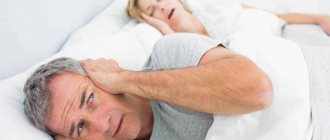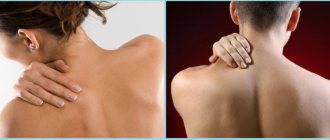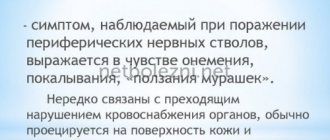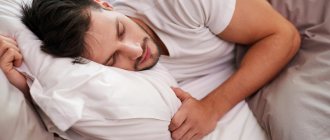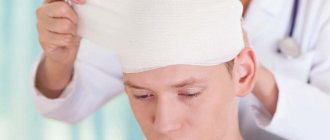Types and mechanism of “goosebumps”
The sensation of tingling and crawling is medically called “paresthesia.” They appear in response to irritation of nerve endings, the brain or spinal cord. The nature of this phenomenon is as follows: the sensitive nerve ending receives several different unrelated signals at once, layering on top of each other. As a result, the nerve does not know how to react correctly to this variety, and “turns on” numbness, burning, “pins and needles” or tingling.
Paresthesia is usually felt below the irritated area of the nerve. They may be accompanied by “goose bumps” - “pimples” in the area of hair growth, which is an analogue of the puffiness of fur or quills in animals.
Paresthesias can be:
- temporary, occurring when sitting in an uncomfortable position, freezing, sexual arousal, a feeling of euphoria from listening to music or when negative emotions appear. They are usually described as “pins and needles on your legs” and go away when the irritating factor stops. Not accompanied by cramps, pain or sensory disturbances;
- chronic, recurring. They are signs of the disease, and can be accompanied by two types of symptoms:
- indicating damage to the nerve fiber. These are: numbness in the limbs or only in the fingers, tingling sensation, goosebumps. Sometimes local twitching (convulsions) develops here;
- indicating damage to those nerves that are connected to the vessels of this area. This is evidenced by: pale skin, deterioration of temperature and pain sensitivity, cool temperature, hair loss.
Transient (temporary) paresthesia is a variant of the norm and does not require medical intervention. If “goosebumps” run without any visible effect on the skin, you definitely need to look for their cause and eliminate it.
| Then the goosebumps appeared | Where are they felt? | Additional symptoms | What could it be | Which doctor should I contact? How to confirm? |
| After a spinal injury | In the limb area | Numbness, impaired sensitivity and movement in the limbs. With a cervical injury, there may be dizziness and loss of coordination. No goosebumps | Fracture, fracture-dislocation of vertebrae | Neuropathologist X-ray or computed tomography of the spine in the injured area |
| For no reason, but more often - if a person suffers from thrombosis, arrhythmias, hypertension | In the area of one half of the body | Sudden onset of poor sensitivity and inability to move the arm and leg on one side | Stroke | Neuropathologist Examination by an ambulance doctor, a neurologist, computed tomography of the brain performed under the supervision of a resuscitator |
| For no apparent reason | In the area of the limbs, but not on one side of the arm or leg, but grabbing either the foot (hand), or the foot and lower leg (hand and forearm), or the entire limb | Numbness, pallor of the skin, decreased local temperature, hair loss or decreased growth in the area where the “pins and needles” sensation is felt | Poor arterial patency: obliterating atherosclerosis or obliterating endarteritis. There may also be nerve compression | Vascular surgeon, neurologist Ultrasound with Dopplerography of the arteries of the extremities (both). Examination by a neurologist, checking tendon reflexes, electroneurography |
| With frequent alcohol consumption | In the area of the extremities (lower, upper or all) | The same | Alcoholic polyneuropathy | Examination by a neurologist, checking tendon reflexes |
| After an arm/leg injury | In the area of injury, above and below the point of impact | Feeling of “pins and needles”, decreased or increased sensitivity to cold/heat, muscle weakness of only this limb | Nerve fiber injury | Examination by a neurologist |
| After working with paints or heavy metals | Legs, arms | “Goosebumps” on the extremities (usually the legs), while sensitivity in the toe area decreases, and the muscles there become weak. Weakness and decreased sensation may also be observed in the hands, in the glove area, and spread along the arms/legs towards the torso | Toxic polyneuropathy | Examination by a neurologist, determination of sensitivity and tendon reflexes |
| If you have diabetes | In the area of both or four limbs | “Goosebumps” on the legs/arms, decreased sensitivity, muscle weakness | Diabetic polyneuropathy | Endocrinologist together with a neurologist Blood test for sugar (glucose) level, glycated hemoglobin level, electromyo- and electroneurography |
| For no apparent reason | In the area of the lower/upper or all 4 limbs | Changes in temperature and pain sensitivity, cold skin, muscle weakness | Vitamin deficiency (most likely B1) | Therapist – for adults, pediatrician – for children Examination by a neurologist, determination of the level of vitamins in the blood |
| During pregnancy | In the leg area | There are signs of pregnancy. There may be night cramps | Lack of magnesium or calcium | Therapist Determination of calcium and magnesium in blood |
| For no apparent reason | Both on the body and on the limbs | A persistent low fever that does not decrease with antibiotic treatment, but goes away on its own. Often - spots on the skin, there may be a “mesh pattern”. Losing weight. Pain in muscles, joints | Vasculitis | Therapist, rheumatologist Rheumatology tests, LE cells and other tests prescribed by a rheumatologist |
| Against the background of the same type of work | In a separate area of the limb (less commonly, the body) | Pain in this area, loss of sensitivity, “pins and needles”. Pass through time | Pinching or inflammation of a single nerve fiber | Neuropathologist Examination by a neurologist, determination of sensitivity and tendon reflexes |
| After a cold, intestinal infection, vaccination, surgery | It starts from the feet, can end there, and can rise, capturing the legs, thighs, hands, and forearms. Breathing, swallowing, and regulation of vascular tone may be impaired | Numbness, loss of sensitivity, muscle weakness, impaired movement of the limbs or their parts, up to paralysis, which can be treated if started in a timely manner. When immobilization of the limbs occurs, the “goosebumps” disappear | Infectious-allergic polyneuropathy (Guillain-Barré or Guillain-Barré-Landry syndrome) | Neuropathologist, sometimes together with infectious disease specialists Examination by a neurologist, determination of sensitivity and tendon reflexes |
| Either for no reason, or after suffering from acute respiratory viral infection | In any area, but more often - between the ribs | Chickenpox-type blisters are observed in the affected area. This is also accompanied by a burning sensation and pain when breathing | Herpes zoster | Infectious disease specialist together with a neurologist |
| For no apparent reason | Hands, face, mouth area | After goosebumps there is a headache, usually in one half of the head | Migraine with aura | Examination by a neurologist |
| After hypothermia | Separate area of the face | Pain in this area, lacrimation, increased sweating on this side | Trigeminal neuralgia | Examination by a neurologist |
| After an animal bite | At the site of the bite | Increased sensitivity of this area, sensation of a “twitching” muscle, photophobia, hydrophobia | Rabies | The diagnosis is made based on examination by an infectious disease specialist/radiologist |
| For no apparent reason | In any area | Accompanied by a completely different set of neurological symptoms: headache, loss of coordination, decreased vision, loss of sensitivity in any areas of the skin of the face, limbs, and torso | Multiple sclerosis, some mitochondrial diseases | MRI of the brain and cervical spinal cord with contrast, electroneurography, laboratory tests that will be prescribed by a neurologist after examination |
| For no apparent reason | “Goosebumps” appear in paroxysms on any part of the body, the location of which may vary. Most often they are felt in the back of the head | Distorted perception of one's own body parts, failure to recognize objects, inability to perform complex movements, loss of the ability to count and solve arithmetic problems. There may be loss of visual field | Damage (usually by tumor) to the parietal lobe of the brain | Neuropathologist MRI of the brain |
| After hypothermia of the head, overload of the neck muscles. Maybe for no apparent reason | In the back of the head | Severe pain in the back of the head, such as “drilling”, “shooting”, occurs in attacks. During the interictal period, a dull pain in the back of the head may remain. You can find points on the back of the head, pressure on which increases pain and goosebumps | Occipital neuralgia | Examination by a neurologist |
We suggest you find out which doctor treats hair and scalp
If you have goosebumps:
- run around the local area, especially in the limbs,
- this is not accompanied by disturbances of consciousness, vision, breathing, swallowing,
- does not rise to the respiratory tract,
it can be any of the neuropathies of numerous nerves. This diagnosis is made by a neurologist based on a routine examination of the patient. We will not list all the diagnoses in the table, especially since their treatment is the same.
The following important information regarding paresthesia should also be noted:
- the lower (closer to the toes) the area where the goose bumps are located, the closer to the tailbone the pathology is located;
- a large area of goosebumps running from a large (hip or shoulder) joint to the fingers indicates a pathology of the spine, while the reverse movement (from the fingers upward) indicates nerve damage;
- if sensitivity is impaired, pain appears and goosebumps appear in a small area between the hand (foot) and shoulder (thigh), most likely a small nerve fiber is damaged (compressed);
- pain that occurs along with goosebumps
- Goosebumps and sensory disturbances are especially dangerous in patients with diabetes, as well as after an intestinal or cold illness;
- anxiety and an urgent visit to a neurologist should be caused by conditions when, along with goosebumps, it is discovered that the affected area does not distinguish what kind of - sharp or blunt - object has touched it, and also does not distinguish between hot and cold water;
- You need to visit a neurologist or vascular surgeon if the skin where the goosebumps run has turned pale, cold, and has little pale hair growing on it.
The state of the body that imitates “goosebumps” is characterized by a change in the sensitivity of the skin receptors located along the peripheral nerves. The reasons for their appearance imply the presence of disturbances in the nerve fibers.
Unusual sensations occur in the part of the body from which signals about nerve damage come. Moreover, the human brain immediately receives from the skin several unrelated impulses that compete with each other: extinguishing or, on the contrary, exciting one another.
Why does transient paresthesia occur?
In animals, raised fur gives them a menacing appearance and helps keep them warm in winter.
In humans, the feeling of goose bumps appears as a result of the rudimentary pilomotor reflex, which is inherent in many mammals. It occurs when special nerves that originate from the spinal cord are stimulated. As a result, peripheral nerves are excited, which causes contraction of the smooth muscles surrounding the hair follicles. In response to this, contracted muscle fibers lift the hair above the surface of the skin. This phenomenon is called piloerection.
For humans, this reaction has lost its practical meaning, but in animals (for example, chimpanzees, dogs, porcupines, cats, mice, etc.), hair raised above the surface of the skin performs various functions. When reacting to fear, piloerection allows animals to have a more impressive and threatening appearance, and during cold weather, a larger amount of warm air accumulates under the raised hairs, protecting the animal from bad weather.
In humans, the pilomotor reflex, leading to the appearance of transient paresthesia, can be caused by the following factors:
- cold;
- heat;
- fear or other negative emotions, feelings and memories;
- sexual arousal;
- listening to pleasant music;
- a feeling of satisfaction with something;
- unpleasant sounds;
- circulatory disorders due to uncomfortable posture.
This type of goosebumps is always caused by certain reasons, is not accompanied by painful sensations and goes away on its own after a short period of time.
Transient paresthesia is normal and should not cause concern about your health.
Description of the phenomenon
- rapidly developing;
- the condition progresses slowly;
- long-term form;
- short-term appearance.
Doctors differentiate “goosebumps” in the area of the trigeminal nerve separately.
Goosebumps appear when nerve endings in the spinal cord or brain are irritated. The reason is the stimulation of individual nerves, which has such an effect on their endings. The irritation causes muscle contraction, causing a sensation as if the hair on the head has risen, and tiny bugs have begun to run across the skin itself. This phenomenon can affect not only the head, but also any other part of the body where there is at least a little hair.
Goosebumps can be one-time (temporary). In this case, they appear for completely natural reasons in a healthy person. Sometimes they can be combined with seizures, loss of sensation, dizziness, but no medical intervention or medication is required. Goosebumps appear for the following reasons:
- Emotional arousal (joy, surprise, fear);
- Touching sensitive skin;
- Low air temperature, hypothermia;
- High body temperature;
- Poor health (weakness, fatigue, headache).
When such sensations appear under the conditions listed above, there is no need to worry. After some time, the goosebumps will disappear on their own, and not a trace will remain of the unpleasant feelings.
In what cases is treatment prescribed for paresthesia?
Glycine is a mild sedative.
If you experience one-time goosebumps that are caused by a psycho-emotional state or an uncomfortable posture, you can ignore their appearance, since it is caused by physiological reasons, is characteristic of absolutely all people and does not indicate pathology. Impressive people may be advised to take mild sedatives (for example, Glycine or herbal medicines) and remain calm in the current situation. And if paresthesias associated with poor circulation, caused by an uncomfortable posture, appear, it is recommended to abandon them (for example, purchase a comfortable pillow for sleeping or a chair for work, do not sit in the cross-legged position, etc.).
When pathological paresthesias appear, the main goal of treatment will be aimed at eliminating the pathology that provoked their development. To identify it, the patient may be prescribed the following types of diagnostic tests:
- radiography of the spinal column;
- Doppler examination of the vessels of the neck and head;
- ECG;
- Echo-CG;
- EEG;
- rheovasography;
- MRI of the spinal cord and/or brain;
- electroneuromyography;
- laboratory tests, etc.
The tactics of further treatment will depend on the cause that caused the appearance of chronic paresthesia. If diagnostic studies have not made it possible to establish a definite diagnosis, then to eliminate the annoying sensations of goosebumps, the following may be prescribed:
- medications: B vitamins, Nicotinic acid, Piracetam, Trental, Actovegin;
- physiotherapeutic procedures: dynamic currents, magnetotherapy, electrophoresis, mud therapy, balneotherapy and massage.
The appearance of crawling sensations on the skin may be normal or indicate the development of various pathologies. Listen carefully to your body, and if you experience frequent and unexplained paresthesias, consult a doctor.
Sometimes this symptom can indicate the development of serious diseases, and timely measures will allow you to avoid the progression of the disease and the development of serious complications. Remember this and be healthy!
Goosebumps on the face and hands
Temporary paresthesia without other signs is not abnormal and does not require intervention. However, if the condition becomes chronic, then you need to contact specialists for help.
Migraine
The characteristic features of migraine are:
- intense, throbbing pain that focuses on one side of the head;
- nausea, vomiting;
- acute reaction to smells and sounds.
Preceding an attack:
- lethargy;
- irritability;
- “goosebumps” on the leg or arm;
- numbness;
- speech is confused or there is no understanding;
- hallucinations.
This period takes from 30 to 60 minutes, then pain and other symptoms occur. The attacks are relieved with the help of triptans. A neurologist treats the pathology.
Tumors inside the skull can be benign or malignant (accounting for 1.5%).
There are a number of general brain symptoms that can be used to judge the presence of problems in the frontal lobe:
- pain;
- nausea and vomiting;
- dizziness;
- optic nerve disorder;
- psychical deviations;
- epileptic seizures;
- disturbance of sensitivity (“goosebumps”, numbness);
- speech and communication disorders;
- hallucinations;
- changes in a person’s behavior and character;
- weakness in the legs.
Treatment of pathology is carried out with the appointment of surgical intervention or intensive care. Neurosurgeons treat the disease.
If goosebumps crawl on the skin of your face and hands, this may be one of the following pathologies.
Migraine
At first, goosebumps appear on the face (especially around the mouth) and hands, then a headache develops mainly in one half of the head. In this case, paresthesia should be regarded as a migraine aura - a condition that precedes an attack of pain.
We suggest you familiarize yourself with Stretch marks on the abdomen and chest during pregnancy: why stretch marks appear and how to deal with them
Migraine
When should you contact a specialist?
Urgent medical attention may be needed if the following factors are present:
- Attacks of numbness are often repeated.
Body temperature has increased.- There is an acute headache.
- There is a lack of coordination of movements and dizziness.
- Loss of hearing or vision.
- Blood pressure surges.
- Numbness of the tip of the tongue, lips and fingers.
- The duration of this skin condition can be up to two hours or more.
If you have such symptoms, you cannot hesitate. Stroke most often manifests itself exactly like this. Emergency medical care can save a person's life.
Treatment is prescribed after a complete examination. Based on the tests received and the results of the study, the doctor can make a diagnosis, talk about the progress of treatment and offer options for combating the disease.
Diagnostics
You should not seek medical help if you have a few spots or floaters that do not cause much discomfort.
Symptoms that require you to see a doctor:
- the number of spots before the eyes has increased sharply;
- in addition to cloudiness, flashes, sparks and lightning appear in the eyes;
- flying floaters appeared after an eye injury or eye surgery;
- in addition to floaters, painful sensations occur in the eyes;
- in addition to opacities, the “picture” splits;
- vision deteriorated sharply.
For an accurate diagnosis in these cases, it is necessary to consult an ophthalmologist and a neurologist. In addition, examinations should be carried out using special instruments.
First aid
If your head is numb not because of a disease, but only because of an external factor, then getting rid of these sensations will not be difficult. You just need to change your position and calm down.
If the provoking factor is cold, you should dress warmly, and you can also apply an alcohol compress. But just don't overdo it. If the sensitivity of the skin is reduced, careless actions can cause a burn. The first aid is to try to improve blood circulation. This must be done both at the location of the numbness and in an attempt to improve blood circulation throughout the body.
- It is necessary to massage the entire scalp, especially the area with reduced sensitivity.
- Drink hot tea with ginger.
- Take a comfortable, relaxed position.
- Calm down and relieve anxiety with the help of calm music, good thoughts, meditation.
Treatment
There are a number of physiological manifestations of “pins and needles” on the legs that do not require intervention; they are summarized in the table.
| Phenomenon | Cause |
| Paresthesia in the morning | During sleep, nerve endings are compressed by blood flow. |
| Uncomfortable shoes | Likewise. |
| Freezing feet | When exposed to cold, blood vessels constrict, and when warm, they expand, causing “goosebumps.” |
| Leg injuries | Impacts can pinch and damage nerves. |
| Smoking | Paresthesia is caused by a lack of oxygen and a lack of vitamin C. |
| Dehydration | Unpleasant phenomena can develop due to seizures associated with the loss of calcium, magnesium, and sodium. |
Disorders in the lumbosacral plexus usually appear with penetrating wounds of the peritoneum, and paresthesia is observed. Treatment is aimed at relieving the cause of the pathology.
Varicose veins
Paresthesia refers to non-obvious symptoms of varicose veins, which include:
- itchy sensations in the knees and ankles;
- cramps in the calf muscles;
- change in skin color;
- increased pain in the legs after immobility;
- numbness of the feet;
- swelling.
Treatment of the disease depends on its stage: in the initial period, conservative methods are used, in an advanced state - surgical intervention.
A condition characterized by discomfort in the lower extremities, especially during sleep and rest, is called restless legs syndrome. It provokes sleep disorders. Features of the disease include itchy sensations in the knees, goosebumps, swelling or squeezing in the legs. Treatment is aimed at correcting the underlying disease.
Tunnel syndrome, which affects the median femoral nerve, appears with a sedentary lifestyle.
Symptoms observed:
- burning in the thighs;
- decreased sensitivity, numbness;
- pain under the skin;
- pale and dry skin;
- varicose veins;
- trophic ulcers.
At the primary stage of the disease, conservative therapy is carried out, in the later stages - surgical intervention.
The collection of cerebrospinal fluid is a lumbar puncture - this is a neurological research method, after which the following may be observed:
- headache;
- spinal cord injuries;
- paresthesia.
The phenomenon does not require treatment and goes away on its own.
Any interventions can lead to disruption of the spinal circulation, which can lead to loss of sensitivity, paresis, urination and defecation disorders.
After surgery, it is necessary to undergo a rehabilitation program.
A pinched femoral nerve is indicated by:
- sharp pain in the pelvic area, which radiates to the lower back;
- loss of leg functionality;
- muscle weakness;
- "goosebumps" on the leg.
With the help of conservative treatment based on steroids and vitamin complexes, it is possible to relieve neuropathy.
The longest branch of the femoral nerve, as a result of compression, can cause:
- pain on the outer surface of the thigh and lower leg;
- walking impairment or knee dysfunction;
- "goosebumps" and loss of sensitivity.
Therapy includes medications, exercise, and physical therapy.
Rabies
A viral disease that causes mortality in 90% of cases, resulting from animal bites, has the properties:
- increased body temperature;
- soreness at the site of the bite;
- paresthesia (burning at the wound site).
First aid consists of washing the wound with antiseptics and vaccination.
Treatment options depend on what is causing the problem. If the doctor has made a diagnosis, then you should take a course of the medications that he prescribes. Only getting rid of the root cause will allow you to forget about unpleasant symptoms forever. The treatment itself includes two methods of influencing the body: medicinal and folk. They can be used simultaneously if there are no contraindications.
Only the attending physician can prescribe medications. It is highly not recommended to purchase and take medications on your own, because... This can cause irreparable harm to your health.
Your doctor may prescribe the following types of medications:
- Sedatives (Glycine, Motherwort, Valerian). Calms the nervous system.
- Antihypoxants (Mexidol, Preductal). Reduce the risk of developing hypoxia.
- Vasodilators (Cavinton, Nicergoline). Improves blood circulation.
- Angioprotectors (Ginkgo-Biloba, Ascorutin). Tones the veins and blood vessels in the head.
- Preparations with vitamin B (Thiamin, Pyridoxine). Improves the quality of nerve tissue.
You can only take mild sedatives (Valerian, Glycine) and painkillers (Nurofen, Paracetamol) on your own. However, it is important to consider the dosage and also try to see a doctor as soon as possible.
You can also be treated with non-drug means. Some patients are prescribed massage, magnetotherapy, peloid therapy, therapeutic exercises, and electric shock. Also, to increase effectiveness, you may need to adhere to a daily routine, quality sleep and a light diet.
Traditional methods
You can cope with goosebumps at home using traditional methods. They will improve the general condition of the body, after which all unpleasant symptoms will disappear. To do this you will need to use the following recipes:
- Parsley root, flax seeds, pumpkin leg, lilac and chicory flowers, horseradish, dandelion, watermelon rinds - take 2 tbsp. l. and pour 300 ml of boiling water. Let it brew. Take 50 ml every morning and evening.
- Nettle leaves, lingonberries, clover, dill, mint, echinacea - mix all ingredients 2 tbsp. l. and pour 500 ml of boiling water for half an hour. Take 50 ml at night.
We suggest you familiarize yourself with the remedy for nasolabial folds
It is important to drink the first tincture first, and only then the second. Additionally, you can drink tea with mint or lavender, because... they have a relaxing effect.
This symptom is accompanied by many diseases. Let's consider the main ones in more detail.
Hypovitaminosis B1
Vitamin B1 is needed for the normal functioning of the nervous system. It is involved in the production of acetylcholine - a substance that allows a nerve impulse to reach the muscle, intestines, sweat gland, heart - and transmit its command to it. Its insufficient intake from food or acceleration of its breakdown leads to:
- feeling of pins and needles on the legs and arms;
- irritability;
- headache;
- memory impairment;
- constipation;
- increased heart rate;
- pain in the heart;
- swelling;
- shortness of breath;
- sometimes even paralysis and cardiovascular failure.
Such symptoms require prompt diagnosis and treatment: administration of synthetic vitamin thiamine and diet correction.
Hypoparathyroidism
This is a reduced function of the parathyroid glands, in which the level of calcium in the blood decreases. It manifests itself not only as goose bumps in the limbs, but also:
- painful contractions of the muscles of the limbs, body and face: the arm is brought towards the body, it is “bent” at the wrist and elbow joints, the corners of the mouth are lowered, the eyelids are lowered by half, the body is arched back;
- swallowing is paroxysmally impaired;
- there is a stabbing pain in the abdomen;
- there may be vomiting, diarrhea;
- fainting occurs;
- twilight vision is impaired;
- "pawns ears;
- there are pains and interruptions in the heart;
- hair becomes thinner, the number of hair shafts falling out increases;
- the skin is peeling;
- a large number of teeth are affected by caries;
- nails become dull;
- With prolonged absence of therapy, cataracts develop.
Here the same symptoms develop as with hypoparathyroidism, but they are not as pronounced and occur more easily. Often, the pathology is manifested only by painful spasms of the muscles of the limbs and face, which immediately follow goosebumps, increased heart rate, trembling and recurrent vomiting. With an extremely low level of this electrolyte in the blood, difficulty breathing may develop until it stops, and painful arching of the entire body.
This condition manifests itself:
- weakness;
- lack of appetite;
- nausea, vomiting;
- trembling of the body or individual muscles;
- Convulsions may occur in which the entire body contracts or arches. This is most common in children.
The appearance of goose bumps can be caused by taking drugs such as: Ofloxacin, Protionamide, Isonazid, Cycloserine, drugs against epilepsy and blood pressure lowering drugs.
Arrhythmias
In the case of the development of attack-like (paroxysmal) rhythm disturbances, a person may notice:
- “goosebumps” running over the body;
- chills at normal body temperature.
This state lasts from ten minutes or more; most often develops at night.
Brain stroke
Paralysis or partial immobility of the limbs on one side may be preceded by a feeling of numbness and crawling, sometimes on the opposite side. There is also a headache, there may be short- or long-term loss of consciousness, focal symptoms are observed: facial asymmetry, different widths of the palpebral fissures, inability to speak or understand speech.
A tumor or encephalitis that develops in the lobe responsible for sensitivity is accompanied by other symptoms: the inability to perform complex actions, failure to recognize objects if you close your eyes and feel them with your hands, loss of the ability to write. There may also be loss of half of the visual field and loss of awareness of one's own body diagram.
This condition occurs after a viral infection (mainly colds and herpes), or intestinal infection caused by the Campylobacter bacterium or enteroviruses.
Here, in the period from 5 to 21 days after the illness, antibodies are formed to certain areas of the spinal nerve roots. This is manifested by the appearance of pins and needles on the legs, the range of movements gradually decreases, and sensitivity is impaired. The process may appear immediately on your hands.
Head injury
A brain contusion can lead to the appearance of pins and needles on both one and two sides. After this, loss of sensation may develop.
Shingles
The disease is caused by the same virus as chickenpox; occurs in those who have already had it. It manifests itself as the appearance of goosebumps in the projection of any nerve, but more often - one of the intercostal nerves. Goosebumps precede the appearance of redness here, on which bubbles with transparent contents soon appear. The affected area burns and hurts.
Multiple sclerosis
Why does chronic paresthesia occur?
Chronic paresthesia is always a sign of pathologies that are accompanied by damage to peripheral nerves. There are many reasons for their appearance:
- hypo- or avitaminosis (usually due to a lack of vitamins B1, D, and C);
- decreased blood levels of calcium and/or magnesium;
- decreased blood glucose levels;
- injuries;
- metabolic disorders (for example, diabetes mellitus);
- alcoholism;
- injuries;
- osteochondrosis;
- herniated intervertebral discs;
- spinal cord tumors;
- carpal tunnel syndrome;
- Raynaud's syndrome;
- shingles;
- atherosclerosis;
- migraine;
- hypertensive crisis;
- restless legs syndrome;
- neurasthenia;
- depressive disorders;
- hypoparathyroidism;
- varicose veins;
- obliterating endarteritis;
- neuralgia;
- vegetative-vascular dystonia;
- myositis;
- multiple sclerosis;
- Bell's palsy;
- follicular hyperkeratosis;
- inflammation of the gums;
- long-term use of certain medications (Methaqualone, Ofloxacin, Isoniazid, Cycloserine, Prothionamide, antihypertensive and antiepileptic drugs);
- rabies, etc.
All of the above reasons lead to the appearance of pathological paresthesias, which occur for no apparent reason, are longer lasting and are accompanied by unpleasant or painful sensations. Their appearance should always be a reason to contact a local physician, who can analyze the patient’s condition and refer him to a specialist (for example, an endocrinologist, neurologist, phlebologist, etc.).
Sometimes pathological paresthesia occurs when filling material gets into the tooth canal or after tooth extraction (especially often after the removal of a wisdom tooth). In such cases, crawling sensations and numbness are observed in the area of the lips, tongue and chin. Sometimes these symptoms disappear after a few days, but in most cases they can last for 2-3 months and require treatment (in some cases even surgery).

